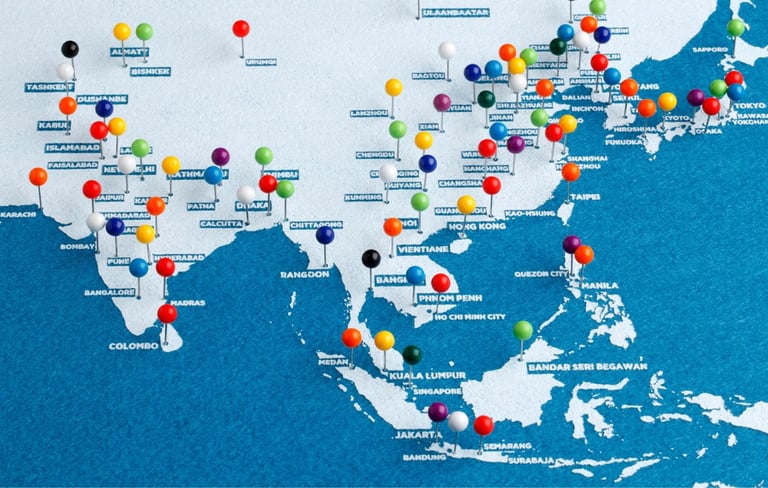2024 Asia's Business Opportunities and Dynamics
ASIA BUSINESS FACTSBUSINESS TIPS
Alan Wong
3/19/202410 min read


Asia's Business Frontier: Opportunities and Dynamics in the World's Growth Engine
Asia stands as a continent of unmatched diversity and dynamism, offering a myriad of opportunities that have consistently attracted global business attention.
Its vast landscape is a fertile ground for innovation, growth, and prosperity, making it an irresistible draw for companies looking to expand their horizons.
This article aims to navigate through the intricate business environment and market dynamics of Asia, leveraging insights from a variety of sources to present a detailed exploration of the region's unique allure for businesses.
From burgeoning economies to technological hotspots, we will uncover the essence of what makes Asia a compelling destination for business ventures and investments.
The Ever-Evolving Business Landscape of Asia
The Asian market is experiencing an unprecedented surge in innovation and growth across various sectors, offering a fertile ground for businesses ready to seize emerging opportunities.
Marketing Opportunities: Artificial Intelligence (AI)
Asia's foray into AI is marked by substantial investments and strategic initiatives.
Singapore's National Artificial Intelligence Strategy, backed by a significant funding pool committed over SGD500 million (US$370 million), exemplifies the region's commitment to AI development.
The semiconductor industry, crucial to AI's expansion, is seeing vigorous activity with Taiwan and South Korea advancing their chip-making capabilities, and Japan's Towa aligning with South Korean demands.


What are the best strategies for success in the Asian market?
To achieve success in the Asian market, a multifaceted strategy that reflects the complexity and diversity of the region is essential.
Here's an elaboration of the key strategies:
Conduct Market Research:
Understanding the market is foundational to success.
This involves analyzing consumer behavior, market trends, competitor activities, and regulatory landscapes.
In Asia, with its varied markets, what works in one country may not work in another.
Market research should be ongoing to capture rapid changes and emerging trends.
Understand Local Culture and Adapt Localization:
Cultural nuances significantly impact consumer preferences and business etiquette.
Products, services, and marketing strategies need to be tailored to resonate with local traditions, values, and languages.
This means going beyond translation to adapt the core offering to meet local tastes and preferences.
Stay Updated:
Asian markets evolve rapidly, with technological advancements and policy changes occurring frequently.
Staying updated with industry news, technological innovations, consumer trends, economic shifts, and Asia business insights is crucial to pivot or adapt strategies effectively.
Build Local Partnerships:
Establishing relationships with local businesses can provide insights into the local market, help navigate legal and bureaucratic hurdles, and extend business networks.
Partnerships with local firms can also enhance credibility with local consumers and regulatory bodies.
Adapt to the Regulatory Environment:
Asian countries can have complex and varied regulatory environments.
Understanding and complying with local laws and regulations is vital to operate smoothly.
It also helps to anticipate regulatory changes and adapt business operations accordingly.
Embrace Technology:
Asia is home to some of the world’s most tech-savvy populations.
Integrating the latest technology in operations, marketing, and customer service can provide a competitive edge.
This also includes leveraging data analytics or CRM tools to gain customer insights and improve decision-making.
Foster Innovation:
The Asian market favors innovation.
Companies that offer innovative products or services that address local challenges or consumer needs can establish a strong market position.
This can involve innovating in product design, delivery systems, or business models tailored for Asian consumers.
Implementing these strategies effectively requires a deep understanding of the region’s unique characteristics, an agile approach that can respond to rapid market changes, and a commitment to invest in local capabilities.


The Asia Key Market Opportunities: China
Based on the latest available data, China maintains its position as the second-largest economy globally with a significant lead in Asia. (Asia Economy Ranking #1, US$18,566 billion in GDP)
Despite concerns about its economic slowdown, China's large-scale manufacturing and production capabilities remain integral to the global supply chain.


The Asia Key Market Opportunities: Japan
Japan continues to be a major economic force, now ranking as the second-largest economy in Asia and fourth in the world. (Asia Economy Ranking #2, US$4,291 billion in GDP)
The recent surge in Japan's stock prices, surpassing heights not seen since 1989, indicates a robust economic sentiment.
Additionally, the establishment of a semiconductor factory by TSMC in Kumamoto signifies Japan's growing influence in the high-tech sector.
The country's tourism sector also exhibits resilience and contributes to economic recovery, even without the influx of Chinese tourists.


The Asia Key Market Opportunities: India
India emerges as the fifth-largest economy globally and the third in Asia, demonstrating rapid economic advancement. (Asia Economy Ranking #3, US$4,112 billion in GDP)
Goldman Sachs projects a significant increase in India's affluent population by 2027, supported by consistent GDP growth exceeding 6% annually from 2023 to 2028.
India's stock market is also gaining prominence, recently surpassing Hong Kong to become the world's fourth-largest.
The Indian government's policies, especially those promoting the 'Make in India' initiative, reflect a strategic push to enhance the country's manufacturing sector and reduce dependence on tech imports.


The Asia Emerging Market Opportunities: South Korea
South Korea, with its dynamic economy, holds the position as the fourth-largest in Asia. (Asia Ranking #4, US$1,784 billion in GDP)
It's particularly notable for its vibrant startup ecosystem which has been flourishing, thanks in part to robust venture capital funding and government financing programs.
South Korea is also carving out a significant niche in high bandwidth memory, providing an edge to its DRAM companies and showcasing its structural opportunities within the tech sector.


The Asia Emerging Market Opportunities: Indonesia
Indonesia should not be overlooked when discussing Asia's emerging markets.
It has established itself as a key player in e-commerce, commanding a 40% share of the Southeast Asian market with a valuation of $77 billion, and projections suggest this could escalate to $130 billion by 2025.
Furthermore, Indonesia's plan to relocate its capital city is an ambitious move to alleviate the congestion in Jakarta, which could have far-reaching implications for the country's economic landscape.


The Asia Emerging Market Opportunities: Taiwan
Taiwan's economy has witnessed record highs, buoyed by a boost in AI stock.
The focus on manufacturing AI chips, led by industry giants like Taiwan Semiconductor, positions Taiwan as a cornerstone in the critical AI sector.
With AI's growing importance in the global economy, Taiwan's specialized chip production is likely to remain a significant contributor to its economic growth.
These markets, with their unique strengths and strategic initiatives, are indicative of the broader dynamism and potential within Asia's emerging markets.
As they continue to develop and expand, keeping a close eye on these economies would be prudent for investors and businesses looking to engage with Asia's diverse markets.


Marketing Opportunities: E-commerce
E-commerce in Asia is poised for a monumental leap forward, with projections estimating its market value to reach $2.7 trillion by 2025, constituting a major portion of global e-commerce activity.
China, Japan, and South Korea, along with Southeast Asian countries, are at the forefront of this e-commerce revolution, with Singapore leading the charge in establishing digital trade pacts, such as the Digital Economy Agreement with New Zealand and the UK, further enhancing the region's e-commerce ecosystem.


Marketing Opportunities: Fintech
The Asian fintech sector is burgeoning, driven by groundbreaking developments in mobile payments, digital banking, and blockchain technology.
These advancements are set to revolutionize financial transactions, especially in cross-border payments, while Southeast Asia is rapidly becoming a hotbed for fintech innovation and adoption due to its highly mobile-engaged population.


Marketing Opportunities: Biotech and Healthcare
Transformation in healthcare is underway in Asia, fueled by a demand for advanced and quality services.
Cutting-edge innovations such as telemedicine, digital health platforms, and genomics are carving new paths for investment.
The healthcare market in Asia is on track to reach significant heights, reflecting a robust growth trajectory in this sector.


Why Global Businesses are expanding to Asia?
As Asia continues to stand as a pivotal growth engine in the global economy, it draws global businesses with its cost-effective production landscape, bolstered by government support, and its burgeoning population wielding significant consumption power.
Eastspring Investments spotlights Asia's transformational phase, noting that savvy global CEOs are adapting their business models to meet the region's evolving market trends.
This process of reinvention is a catalyst for discovering new investment and expansion opportunities.
At the heart of Asia's burgeoning influence is the digital revolution, propelled by the widespread usage of smartphones and internet connectivity.
Asia is swiftly becoming a digital fortress, with innovative technology startups and a robust e-commerce ecosystem.
Furthermore, the region's commitment to sustainability and social responsibility is gaining prominence, with environmental challenges and social awareness driving companies to adopt greener practices.
The healthcare industry in Asia is experiencing robust growth, spurred by demographic shifts like an aging population and increased healthcare demands.
The fintech sector is also witnessing a surge, as it offers cutting-edge solutions to an increasingly sophisticated consumer base seeking financial services.
The confluence of these factors makes Asia an irresistible destination for businesses aiming to tap into a market full of vitality and opportunity, solidifying its role as a critical hub for business expansion in the modern economy.


Why are the current economic issues in Asia?
However, the global economy and particularly Asian markets are not without challenges.
The landscape for Asian countries in 2024 is one of economic transition and geopolitical shifts that carry both risks and opportunities.
China, which is a major economic powerhouse in the region, is expected to navigate a shift away from its previously dominant real estate sector and broaden its economic activities into other areas.
Geopolitical tensions, particularly those impacting the Middle East, present a significant risk to the global economy due to their potential to disrupt critical food and energy supplies.
This could lead to increased energy prices and have inflationary effects, hampering investment, and economic growth and impacting the cost and logistics of goods entering and leaving Asia.
On the financial front, the global environment of rising interest rates may exert additional pressure on economies, especially those with high debt levels.
The ability of some countries to service their debt could become strained, potentially leading to increased financial stress and repercussions for global growth.
Trade fragmentation is another issue that's increasingly impacting global economics.
Policies that restrict trade or promote 'friend-shoring' and 'near-shoring' may seem beneficial for national security or resilience in supply chains but could also have the unintended effect of fragmenting global trade and impacting economic efficiency and growth.
The policy environment and economic performance in 2024 will also be shaped by key elections across the region, which may lead to changes in governance and policy directions, further influencing economic outcomes and market opportunities in Asia.
Amidst these challenges, the IMF suggests that the Asia-Pacific region will remain a significant contributor to global growth, despite potential headwinds from the changing global demand and tighter monetary policies.
The region's growth, while expected to slow, is still projected to maintain a relatively healthy pace compared to other areas.
Asian economies are advised to continue policies to manage inflation effectively, strengthen financial stability, and undertake structural reforms to promote productivity and inclusive growth


Will Asia overtake the West in an economic leadership role?
While Asia may not be poised to overtake the West entirely, its increasing significance in global economic activities, particularly in sectors like semiconductor production, is undeniable.
This sectoral growth aligns with the classical economic theory of comparative advantage, which suggests that nations prosper by specializing in producing and exporting goods and services for which they are relatively more efficient producers, leveraging the benefits of the division of labor.
Moreover, the diligent work culture and competitive spirit prevalent in many Asian countries can offer substantial benefits to Western corporations expanding into the region.
The integration of Asian diligence and aggressiveness into business practices can lead to increased productivity and competitiveness in the market.
Ultimately, both Western and Asian nations can reap the rewards from international trade.
Through the exchange of goods and services, each region can enjoy a greater variety of choices, enhanced innovation, and more efficient resource utilization, contributing to economic growth and development on both sides.
This mutual benefit underscores the essence of global trade, where diverse strengths and capabilities across the globe are leveraged for shared prosperity.
With over 50 years of experience combined with our team at ToAsia.biz, we are ready to provide business consultation services to lead your business into the Asia Pacific region - profitably.
Talk to us now and see how our playbook is different from business consultants out there where our focus is to help you expand at the right pace, staying lean and profitable.


Alan Wong is founder of ToAsia.biz and a startup mentor with over 20 years of professional experience managing software, Saas and consulting services MNCs.
About Author
Copyright © 2025 ToAsia.biz


We lead your business to Asia
Our Business Growth Experts help SaaS businesses achieve growth in Asia and become profitable FAST.
Send us a message via WhatsApp
